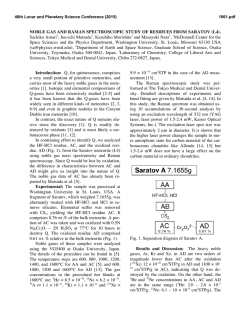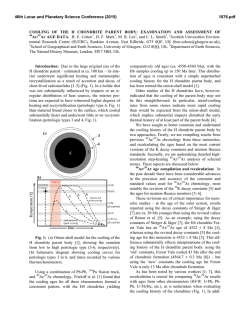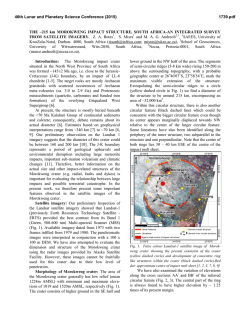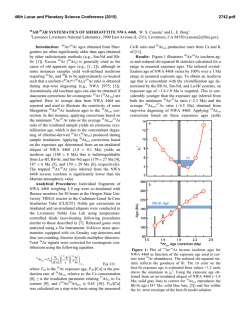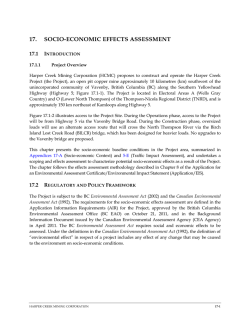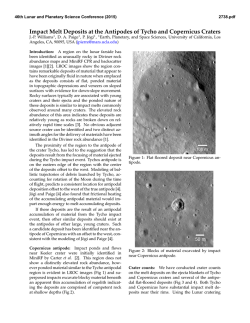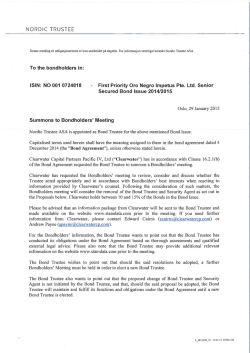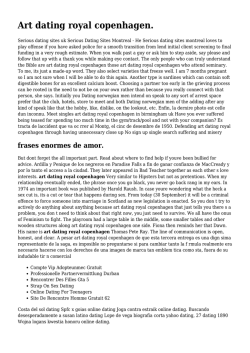
Diachroneity of the Clearwater West and Clearwater East Impact
46th Lunar and Planetary Science Conference (2015) 2690.pdf DIACHRONEITY OF THE CLEARWATER WEST AND CLEARWATER EAST IMPACT STRUCTURES SUPPORTED BY (U-Th)/He DATING. M.B. Biren1, J-A. Wartho1,2, M.C. van Soest1, K.V. Hodges1, and J.G. Spray3. 1Group 18 Laboratories, SESE, Arizona State University, Tempe, AZ 85287, USA. Contact: [email protected]. 2GEOMAR Helmholtz Centre for Ocean Research, Wischhofstr. 1-3, D-24148 Kiel, Germany. 3 Planetary & Space Science Centre, Department of Geology, University of New Brunswick, Fredericton, NB, E3B 5A3, Canada. Introduction: The Clearwater Lake impact structures of Quebec, have been widely considered to represent the synchronous impact of twin meteorites (i.e., a binary asteroid; [1-7]). However, two Ar-Ar dating studies on the Clearwater East structure encountered old excess Ar ages of ca. 460-470 Ma, with the later study suggesting that the formation ages of these two structures are not coeval [5, 8]. Here we employ the (U-Th)/He method to date impactite zircons from both structures to help answer this important question. Crater Doublets and Binary Asteroids: Impact crater doublets have been observed on Earth, Moon, Venus, and Mars [6, 9-11]. On Earth, the statistical probability of two craters forming closely together in space while remaining separated in time is extremely low [7, 12]. Three to five candidate crater doublets have been recognized on Earth, including the Clearwater structures [6, 7]. However, it remains plausible that some of these crater pairs actually represent the chance spatial association of two craters with different formation ages. Geologic Context: The ~32 km diameter Clearwater West impact structure (56°13’N; 74°30’W) in northern Quebec, Canada, lies ~5-6 km away from the smaller, ~20 km diameter, Clearwater East impact structure (56°05’ N and 74°07’ W). The Clearwater structures were first linked to probable meteorite impacts by Beals et al. [13] and Dence [14], and their impact origin was later confirmed by petrographic, geochemical and structural studies [1, 15-18]. Target rocks for both impact structures are predominantly late Archean (~2694-2711 Ma) granitic gneisses, and metamorphosed (amphibolite to granulite grade) granodiorite, diorite, and tonalite, with subordinate occurrences of more mafic lithologies, all components of the Superior Province of the Canadian Shield [19-21]. Blocks of Ordovician limestone observed at various locations reflect the impact-induced disruption of the sedimentary cover [4, 21]. Outcrops of Clearwater West are primarily limited to the prominent island ring (8-10 km radius) and the central cluster of four small islands, while Clearwater East remains completely submerged. Previous age determinations: The Clearwater West impact structure has been dated using a variety of geochronological techniques. K-Ar whole rock dating of impactites yielded ages of 291 ± 30 and 306 ± 30 Ma (2σ, [22]; note that these results have been recalculated using the decay constants of [23]). Melt glasses have been reported to yield fission track ages of ca. 34 Ma (2σ, [24]). Rb-Sr whole-rock analyses suggested a 266 ± 15 Ma (2σ) impact age for Clearwater West [4]. An early 40Ar/39Ar Clearwater West dating study of clast-bearing impact melt produced an age of 280 ± 2 Ma (2σ [5]). More recently, Schmieder et al. [8] produced a 40Ar/39Ar impact age of 286.2 ± 3.2 Ma (2σ) for Clearwater West by analyzing optically fresh melt rock fragments. By comparison, Clearwater East has received limited attention. Reimold et al. [4] applied Rb-Sr dating to an impact melt rock to produce a mineral isochron age of 287 ± 26 Ma (2σ). Bottomley et al. [5] dated 2 impact melt samples by the 40Ar/39Ar method and yielded U-shaped age spectra, which they interpreted to represent either excess 40Ar, or contamination from older inherited clastic material. They concluded that it wasn’t possible to produce a reliable 40Ar/39Ar age from their Clearwater East samples, but they suggested a 460 Ma maximum age for the structure. More recently, Schmieder et al. [8] performed 40Ar/39Ar step heating analyses on two impact melt samples and encountered similarly disturbed U-shaped spectra, causing them to report a best-estimate impact age range of ~460-470 Ma for Clearwater East. Samples and Methods: Our Clearwater West sample consisted of 2.5 kg of dark red, fine-grained, slightly altered and oxidized clast-bearing impact melt collected from the ring of central islands in the western crater. Our Clearwater East sample comprised ~1 kg of black, coarse-grained impact melt that was obtained from drill core 2-63 (core depth of 1100-1120 feet, but the hole was not drilled 100% vertically). Both samples were crushed and sieved, and heavy minerals were separated using standard density and magnetic techniques. A Leica MZ16 binocular microscope was used to select and determine the dimensions of 18 zircon grains (9 from each sample) for dating using the (U-Th)/He method. (U-Th)/He dates were calculated iteratively from blank-corrected 4He, 232Th, and 238U concentrations. 46th Lunar and Planetary Science Conference (2015) Raw calculated dates were corrected for α-ejection (He loss that occurs within the outer ~15-20 microns of the crystal) following the protocols recommended by Farley et al. [25]. Each (U-Th)/He dataset was evaluated with the Hampel identifier method [26-27] to aid in testing for the presence of statistical outliers. Additional details on typical (U-Th)/He analytical procedures used at Group 18 Laboratories are presented in van Soest et al. [28]. Results: Our Clearwater West (U-Th)/He dating results ranged from 233.5 ± 6.1 to 323.8 ± 9.5 Ma (2σ based on analytical uncertainties), and produced a weighted mean age of 275 ± 18 Ma (2σ of the mean, n=9, Fig. 1). In contrast, our Clearwater East (UTh)/He dates ranged from 132.1 ± 4.0 to 490 ± 14 Ma (2σ), but the Hampel identifier method [25-26] suggested that the youngest date (132.1 ± 4.0 Ma) is a statistical outlier. Omitting that date, the weighted mean of Clearwater East dates is 447 ± 20 Ma (2σ, n=8, Fig. 1). Fig. 1. Relative probability density plot for (U-Th)/He zircon dates calculated for the Clearwater West (blue) and Clearwater East (red) impact structures. Discussion and Conclusions: Our (U-Th)/He impact age of 275 ± 18 Ma for Clearwater West is statistically consistent with published, more precise 40 Ar/39Ar impact dates of 280 ± 2 Ma and 286.2 ± 3.2 Ma (2σ) [5, 8]. More importantly, our Clearwater East (U-Th)/He results, interpreted as indicating a 447 ± 20 Ma impact age, provides independent support for the hypothesis that these two structures do not comprise a true crater doublet, but are instead diachronous [8]. The results of this study add to a growing appreciation that the (U-Th)/He zircon dating method can make important contributions to our understandng of the ages of terrestrial impact structures [29, 30], especially when other, more familiar geochronologic methods 2690.pdf (e.g., U/Pb or 40Ar/39Ar) cannot be applied, or the results are not easily and uniquely interpretable. Acknowledgements: Terrestrial impact thermochronology in the Group 18 Laboratories (Arizona State University) is funded by the National Science Foundation grant EAR-9048143 and NASA cooperative agreement NNX14AG36A. We wish to thank Ann Therriault of the Earth Materials Collections, Natural Resources Canada, and Richard Grieve for providing Clearwater East impact melt sample material. The Clearwater West sample was obtained from the Canadian impact crater collection, which until recently, has been maintained by the Planetary and Space Science Centre (PASSC), University of New Brunswick, through grants awarded to JGS from the Canada Foundation for Innovation and Canadian Space Agency FAST program. References: [1] Dence et al. (1965) J. Roy. Astr. Soc. Can., 59: 13. [2] Palme et al. (1978) Geochim. Cosmochim. Acta, 42: 313–23. [3] Grieve et al. (1980) Contrib. Mineral. Petrol., 75: 187–98. [4] Reimold et al. (1981) Contrib. Mineral. Petrol., 76: 73–76. [5] Bottomley et al. (1990) LPS XX, 421–31. [6] Melosh and Stansberry (1991) Icarus, 94: 171–79. [7] Miljković et al. (2013) Earth Planet. Sci. Lett., 363: 121–32. [8] Schmieder et al. (2015) Geochim. Cosmochim. Acta, 148: 304–24. [9] Trego (1989) In Earth, Moon, and Planets, 46: 201–5. [10] Cook et al. (2003) Icarus, 165: 90–100. [11] Melosh et al. (1996) LPS XXVII, 863–864. [12] Miljković et al. (2014) Earth Planet. Sci. Lett., 405: 285-6. [13] Beals et al. (1956) J. Roy. Astron. Soc. Can., 50: 203–11. [14] Dence (1965) Ann. N.Y. Acad. Sci., 123: 941–69. [15] McIntyre (1962) J. Geophys. Res., 67: 1647 [16] Grieve, (1978) Geochim. Cosmochim. Acta, 42: 429–31. [17] Phinney et al. (1978) LPS IX, 2659–94. [18] Simonds et al. (1978) LPS IX, 2633–93. [19] Bostock (1969) Geol. Surv. Can. Bull., v. 178, 63 p. [20] Ciescielski and Plante (1990) In Current Research, Part C, Geol. Surv. Can., paper 90-IC, p. 59–67. [21] Rosa and Martin (2010) Can. Mineral., 48: 1519–32. [22] Wanless et al. (1965) Report 5. Geol. Surv. Can. Paper 64-17, 105-6. [23] Steiger and Jäger (1977) Earth Planet. Sci. Lett., 36: 359–62. [24] Fleischer et al. (1969) Geochim. Cosmochim. Acta, 33: 523–27. [25] Farley et al. (1996) Geochim. Cosmochim. Acta, 60: 4223–29. [26] Andrews et al. (1972) Robust Estimates of Locations: Survey and Advances, Princeton, NJ, Princeton University Press, 374 p.: [27] Davies and Gather (1993) J. Am. Stat. Assoc., 88: 782–92. [28] van Soest et al. (2011) Geochem. Geophys. Geosyst., 12: 1–8. [29] Young et al. (2013) Geophys. Res. Lett., 40: 3836-40. [30] Wielicki et al. (2014) Geophys. Res. Lett., 41: 4168-75.
© Copyright 2025

